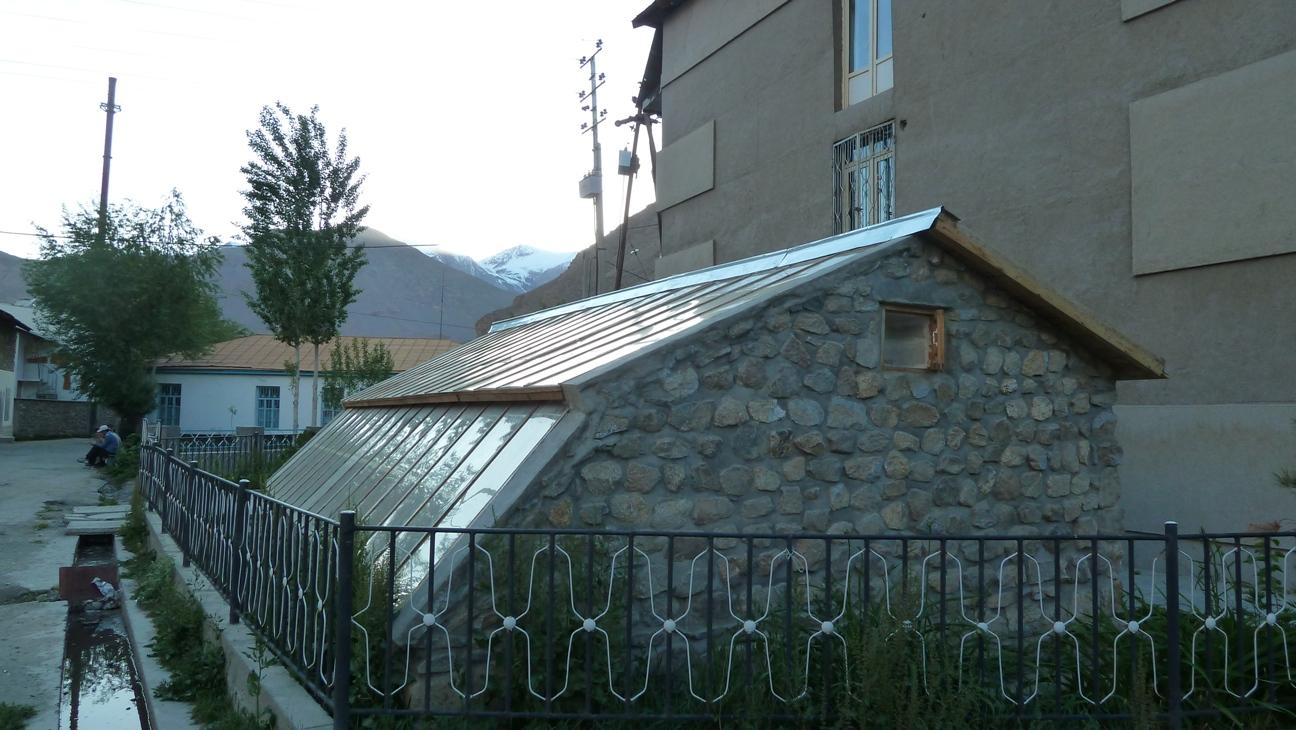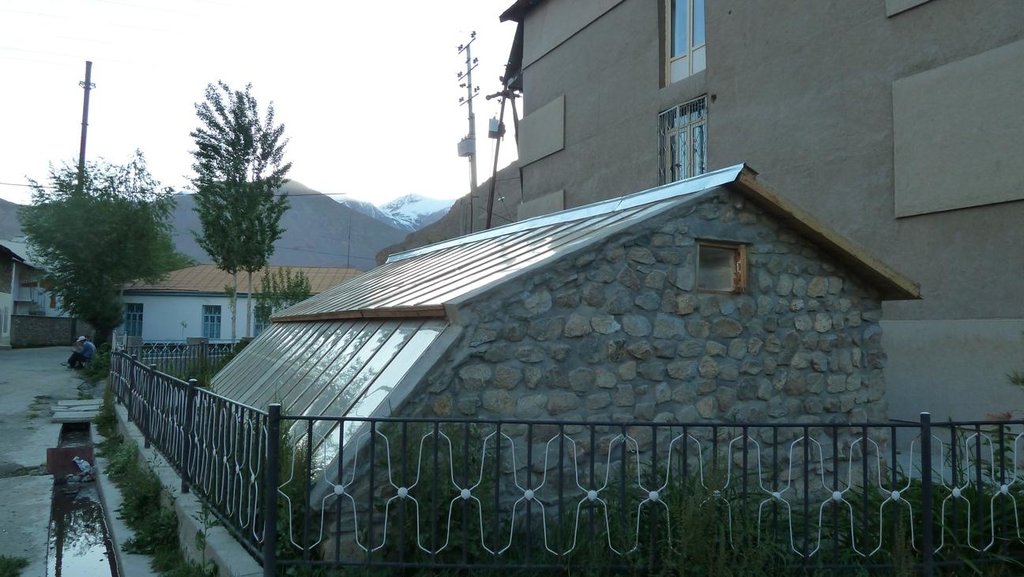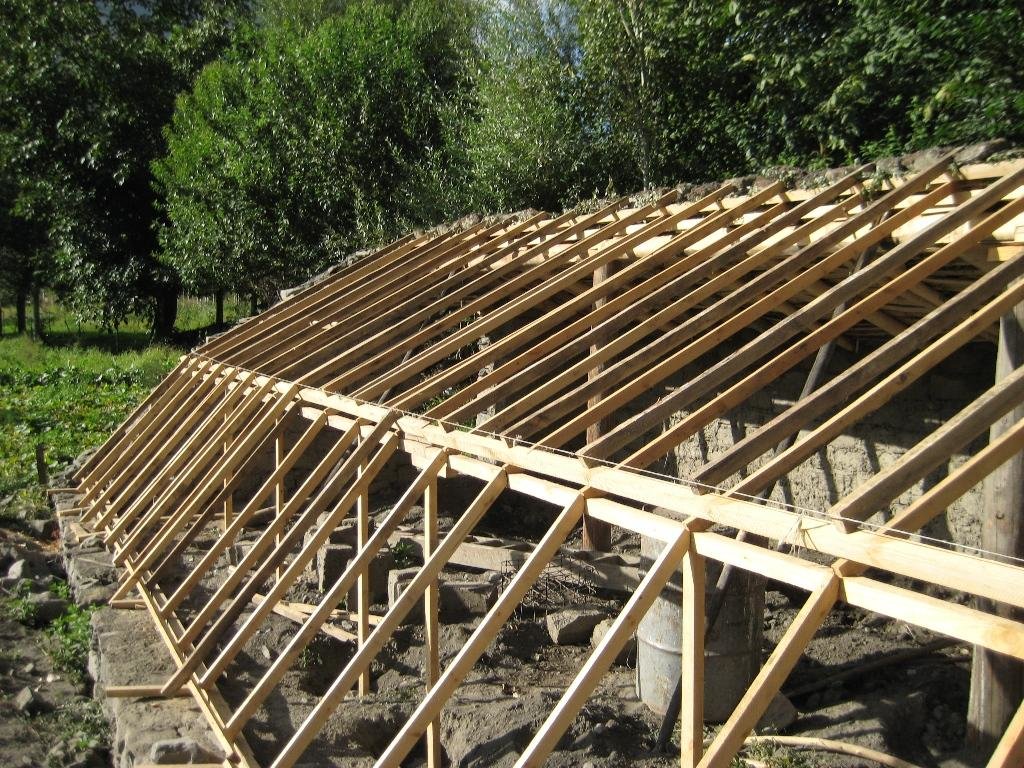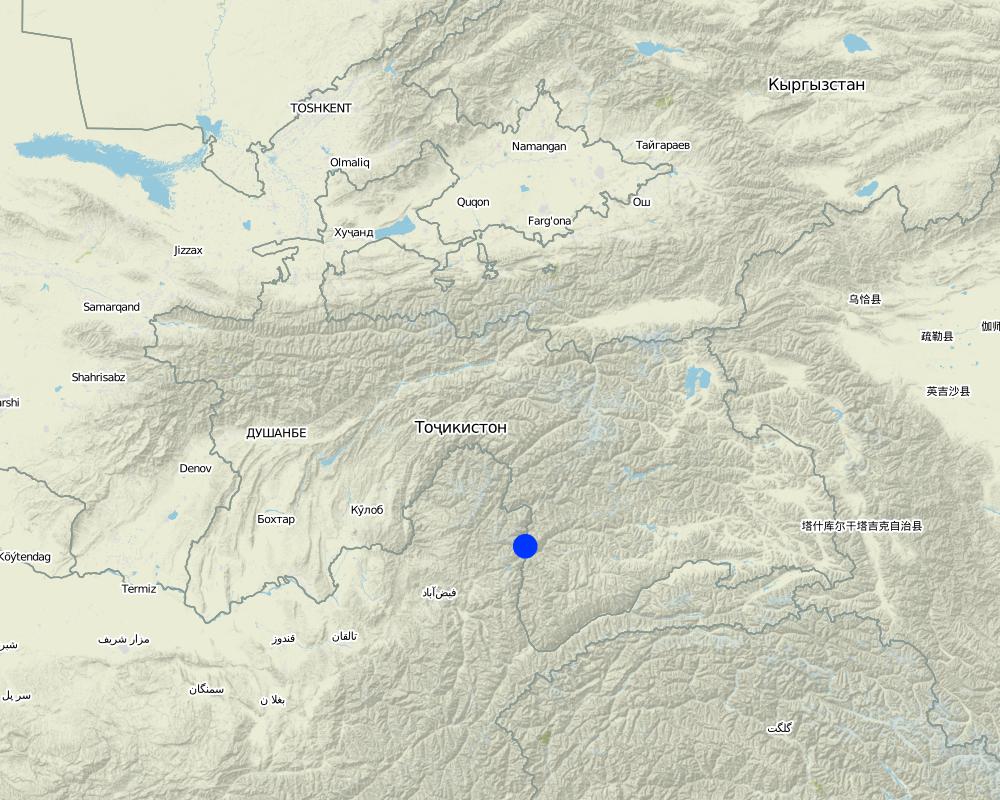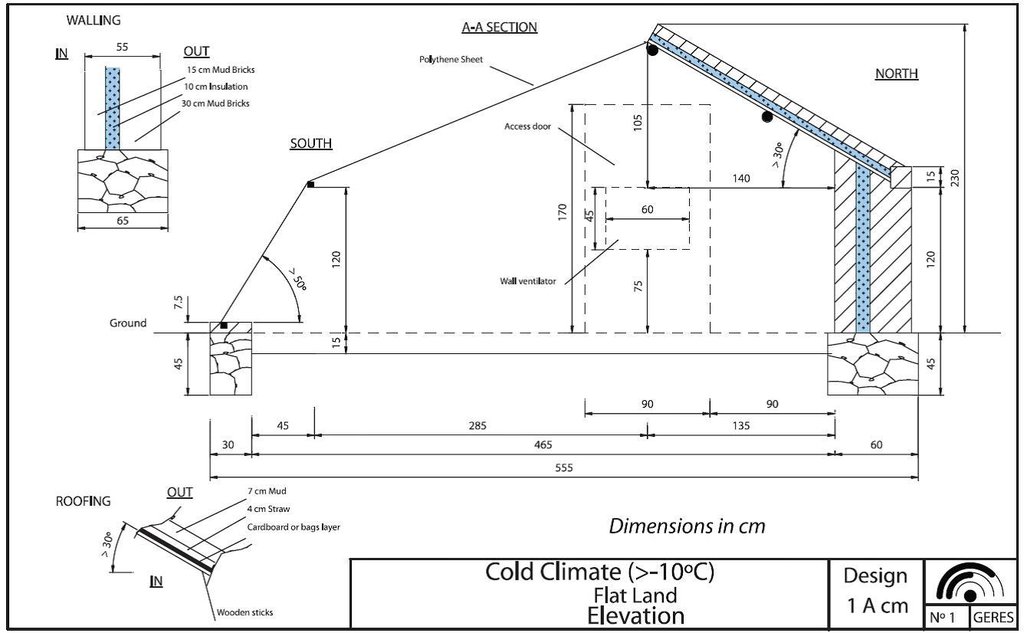Passive solar greenhouses for winter commercial vegetable production [Tayikistán]
- Creación:
- Actualización:
- Compilador: Julie Zähringer
- Editor: –
- Revisores: David Streiff, Alexandra Gavilano
technologies_1041 - Tayikistán
- Resumen completo en PDF
- Resumen completo en PDF para imprimir
- Resumen completo en el navegador
- Resumen completo (sin formato)
- Passive solar greenhouses for winter commercial vegetable production: 21 de marzo de 2017 (inactive)
- Passive solar greenhouses for winter commercial vegetable production: 28 de julio de 2017 (inactive)
- Passive solar greenhouses for winter commercial vegetable production: 19 de agosto de 2019 (inactive)
- Passive solar greenhouses for winter commercial vegetable production: 2 de noviembre de 2021 (public)
Visualizar secciones
Expandir todo Colapsar todos1. Información general
1.2 Detalles de contacto de las personas de referencia e instituciones involucradas en la evaluación y la documentación de la Tecnología
Especialista MST:
Khudonazarov Artur
Manager of the "Centre for Sustainable and Innovative Technology", a project of MSDSP
Tayikistán
Especialista MST:
Shariff Jamil
MSDSP
Nombre de la(s) institución(es) que facilitaron la documentación/ evaluación de la Tecnología (si fuera relevante)
Kyrgyzstan Mountain Societies Development Support Programme, Aga Khan Development Network (MSDSP KG) - Kirguistán1.3 Condiciones referidas al uso de datos documentados mediante WOCAT
El compilador y la/s persona(s) de referencia claves aceptan las condiciones acerca del uso de los datos documentados mediante WOCAT:
Sí
2. Descripción de la Tecnología MST
2.1 Breve descripción de la Tecnología
Definición de la Tecnología:
Passive solar greenhouses heated entirely by sunlight were established with the aim to produce vegetables for commercial use during the harsh winter conditions.
2.2 Descripción detallada de la Tecnología
Descripción:
A passive solar greenhouse is a greenhouse heated entirely by sunlight, with no additional fuel-based heating. In the Pamirs, the temperature inside these greenhouses can be kept high enough to grow vegetables throughout the year, even in winter if the greenhouse is built efficiently. Thus greenhouses can be of great use, particularly in those areas where there are continuing concerns about food security and economic development. These greenhouses were developed by GERES (Renewable Energy and Environment Group) and ICIMOD (International Centre for Integrated Mountain Development) and first tested with farmers in Ladakh, India. MSDSP adopted the idea and introduced it to the GBAO region in Tajikistan establishing 3 demonstration greenhouses in collaboration with farmers in the Shugnan district in 2010.
Purpose of the Technology: A solar greenhouse aims to trap and intensify the heating effect of solar radiation and thus enables plants to be grown that cannot be grown under the normal (outside) ambient conditions. Solar greenhouses are particularly useful in areas where there is a lot of sunshine in winter, but where the air is too cold for growing crops. The main benefits of solar greenhouses are that vegetables can be grown during the winter, helping to fulfill basic subsistence needs of people in remote areas and income generation through selling the produce.
Establishment / maintenance activities and inputs: A greenhouse is only efficient if it is constructed in the right place, in the right way, and is used properly. An efficient solar greenhouse should be designed along an east-west axis, with the length of the south face increased and angled to present the largest possible surface area to the sun, the size of the east and west facing walls reduced to minimise heat loss and provide shade inside the greenhouse, and the north wall should be heavily insulated.
The following steps are required in constructing an efficient greenhouse: (1) selecting an appropriate place: there needs to be a source of running water close to the greenhouse, solar radiation needs to be sufficient (sunrise should be before 9.30 and sunset after 3.00 pm even on the shortest days of the year), the land has to be flat and dry; (2) selecting the most appropriate design: (see manual); (3) constructing the foundation: digging a trench and filling the foundation with mud mortar; (4) preparing the floor; (5) building the double walls separated by one insulation layer; (6) making and installing an access door; (7) making and installing the wall ventilator; (8) constructing the roof; (9) making and installing the roof ventilator (shutter); (10) installing the polyethylene shutter; (11) installing night insulation.
Natural / human environment: The greenhouses were established in three villages of Shugnan district: Buni, Sokhcharv and Darmoracht. Two of these villages are located at about 2,500 metres a.s.l. and receive less than 300 mm of annual precipitation. The farmers who constructed these greenhouses are small-scale farmers with less than 0.5 ha of land available.
2.3 Fotografías de la Tecnología
2.5 País/ región/ lugares donde la Tecnología fue aplicada y que se hallan comprendidos por esta evaluación
País:
Tayikistán
Región/ Estado/ Provincia:
Tajikistan
Especifique más el lugar :
GBAO/Shugnan
Comentarios:
At least 3 greenhouses built in Shugnan district, each one is 50 m2 in size.
Map
×2.6 Fecha de la implementación
Si no se conoce el año preciso, indique la fecha aproximada:
- hace menos de 10 años (recientemente)
2.7 Introducción de la Tecnología
Especifique cómo se introdujo la Tecnología:
- mediante proyectos/ intervenciones externas
Comentarios (tipo de proyecto, etc.):
2010
3. Clasificación de la Tecnología MST
3.1 Propósito(s) principal(es) de la Tecnología MST
- mejorar la producción
3.2 Tipo(s) actuales de uso de la tierra donde se aplica la Tecnología

Tierras cultivadas
- Cosecha anual
- Cucumbers, tomatoes, radishes, salad greens, onions
Número de temporadas de cultivo por año:
- 1
Especifique:
Longest growing period in days: 170Longest growing period from month to month: late April-early October

asentamientos, infraestructura
- Asentamientos, edificios
Comentarios:
Major land use problems (compiler’s opinion): A lack of precipitation and therefore irrigation water, soil erosion, low soil fertility (no fertilisers used or rotations), harsh climatic conditions (high altitude).
Future (final) land use (after implementation of SLM Technology): Cropland: Ca: Annual cropping
3.3 ¿Cambió el uso de tierras debido a la implementación de la Tecnología?

Tierras cultivadas
- Cosecha anual

asentamientos, infraestructura
3.4 Provisión de agua
Provisión de agua para la tierra donde se aplica la Tecnología:
- totalmente irrigada
3.5 Grupo MST al que pertenece la Tecnología
- jardines domésticos
- greenhouse
3.6 Medidas MST que componen la Tecnología

medidas agronómicas
- A2: materia orgánica/ fertilidad del suelo

medidas estructurales
- S11: Otros
Comentarios:
Main measures: agronomic measures, structural measures
Type of agronomic measures: manure / compost / residues
3.7 Principales tipos de degradación del suelo encarados con la Tecnología

deterioro químico del suelo
- Cn: reducción de la fertilidad y contenido reducido de la materia orgánica del suelo (no ocasionados por la erosión)

degradación biológica
- Bq: reducción de la cantidad/ biomasa
- Bs: reducción en la calidad y composición/ diversidad de las especies
Comentarios:
Main type of degradation addressed: Cn: fertility decline and reduced organic matter content, Bq: quantity / biomass decline, Bs: quality and species composition /diversity decline
Main causes of degradation: soil management (no application of fertilisers), deforestation / removal of natural vegetation (incl. forest fires), overgrazing, change of seasonal rainfall (decreased), droughts
Secondary causes of degradation: war and conflicts (during the civil war a lot of vegetation was cut to provide energy)
3.8 Prevención, reducción o restauración de la degradación del suelo
Especifique la meta de la Tecnología con relación a la degradación de la tierra:
- prevenir la degradación del suelo
4. Especificaciones técnicas, actividades de implementación, insumos y costos
4.1 Dibujo técnico de la Tecnología
Especificaciones técnicas (relacionadas al dibujo técnico):
The diagram shows a greenhouse adapted to a cold climate, for greenhouses adapted to different climates please see the manual (annex 1)
GBAO
Date: 2004
Technical knowledge required for field staff / advisors: high
Technical knowledge required for land users: moderate (brochures available in Tajik)
Main technical functions: increase in organic matter, reduction in wind speed, increase of biomass (quantity), spatial arrangement and diversification of land use, production of microclimate suitable for crop growth in winter
Manure / compost / residues
Material/ species: manure is mixed with the soil to cover the floor of the greenhouse
Structural measure: greenhouse
Construction material (earth): mud
Construction material (stone): stone
Construction material (wood): wood (poplar, willow)
Construction material (other): straw, wool
Autor:
GERES / ICIMOD
4.2 Información general sobre el cálculo de insumos y costos
otra / moneda nacional (especifique):
Somoni
Si fuera relevante, indique la tasa de cambio de dólares americanos a la moneda local (ej. 1 U$ = 79.9 Reales Brasileros): 1 U$ =:
4,5
Indique el costo promedio del salario de trabajo contratado por día:
9.00
4.3 Actividades de establecimiento
| Actividad | Momento (estación) | |
|---|---|---|
| 1. | Digging trench for fundament, 60 cm deep | spring |
| 2. | Put fundament using stones mixed with mud | |
| 3. | Build walls: outer layer stones (40 cm width), then insulation layer with straw or wool (10 cm), inner layer out of mudbricks (15-20 cm). Total height of wall is 1.20 m. | |
| 4. | Build doors | |
| 5. | Build wall ventilators | |
| 6. | Build roof: southfacing side put 2 layers of each 40m2 cellophane, northfacing side put woodlogs | |
| 7. | Build roof ventilators | |
| 8. | Install night insulation |
4.4 Costos e insumos necesarios para el establecimiento
| Especifique insumo | Unidad | Cantidad | Costos por unidad | Costos totales por insumo | % de los costos cubiertos por los usuarios de las tierras | |
|---|---|---|---|---|---|---|
| Mano de obra | Digging trench for fundament, | Persons/day | 3,0 | 40,0 | 120,0 | 100,0 |
| Mano de obra | Put fundament | Persons/day | 10,5 | 40,0 | 420,0 | 100,0 |
| Mano de obra | Build walls | Persons/day | 30,0 | 40,0 | 1200,0 | 100,0 |
| Mano de obra | Build doors | Persons/day | 2,0 | 20,0 | 40,0 | 100,0 |
| Equipo | Shovels | Pieces | 2,0 | 20,0 | 40,0 | 100,0 |
| Equipo | Nails | kg | 3,0 | 10,0 | 30,0 | |
| Material de construcción | Cellophane foil | sq m | 80,0 | 4,0 | 320,0 | |
| Otros | Labour: Build wall ventilators | Persons/day | 12,0 | 40,0 | 480,0 | 100,0 |
| Otros | Labour: Build roof ventilators | Persons/day | 4,0 | 40,0 | 160,0 | 100,0 |
| Otros | Labour: Install night insulation | Persons/day | 5,0 | 40,0 | 200,0 | 100,0 |
| Costos totales para establecer la Tecnología | 3010,0 | |||||
| Costos totales para establecer la Tecnología en USD | 668,89 | |||||
Si el usuario de la tierra no cubrió el 100% de los costos, indique quién financió el resto del costo:
MSDSP
Comentarios:
Duration of establishment phase: 1.5 month(s)
4.5 Actividades de establecimiento/ recurrentes
| Actividad | Momento/ frequencia | |
|---|---|---|
| 1. | Replace cellophane | when needed, every 1-2 years for bad material, 5 years for good material |
4.6 Costos e insumos necesarios para actividades de mantenimiento/ recurrentes (por año)
| Especifique insumo | Unidad | Cantidad | Costos por unidad | Costos totales por insumo | % de los costos cubiertos por los usuarios de las tierras | |
|---|---|---|---|---|---|---|
| Mano de obra | Replace cellophane | Persons/day | 2,0 | 40,0 | 80,0 | 100,0 |
| Material de construcción | Cellophane | sq m | 80,0 | 4,0 | 320,0 | 100,0 |
| Indique los costos totales para mantenecer la Tecnología | 400,0 | |||||
| Costos totales para mantener la Tecnología en USD | 88,89 | |||||
Comentarios:
The costs were calculated for the establishment of one 5x10m greenhouse.
4.7 Factores más determinantes que afectan los costos:
Describa los factores más determinantes que afectan los costos:
Apart from the cellophane cover, mainly local materials were used which did not require investments. If labour has to be paid, this is the most determinate factor, also wooden poles if they have to be bought.
5. Entorno natural y humano
5.1 Clima
Lluvia anual
- < 250 mm
- 251-500 mm
- 501-750 mm
- 751-1,000 mm
- 1,001-1,500 mm
- 1,501-2,000 mm
- 2,001-3,000 mm
- 3,001-4,000 mm
- > 4,000 mm
Especificaciones/ comentarios sobre la cantidad de lluvia:
200-300 mm
Zona agroclimática
- árida
Thermal climate class: temperate
5.2 Topografía
Pendientes en promedio:
- plana (0-2 %)
- ligera (3-5%)
- moderada (6-10%)
- ondulada (11-15%)
- accidentada (16-30%)
- empinada (31-60%)
- muy empinada (>60%)
Formaciones telúricas:
- meseta/ planicies
- cordilleras
- laderas montañosas
- laderas de cerro
- pies de monte
- fondo del valle
Zona altitudinal:
- 0-100 m s.n.m.
- 101-500 m s.n.m.
- 501-1,000 m s.n.m
- 1,001-1,500 m s.n.m
- 1,501-2,000 m s.n.m
- 2,001-2,500 m s.n.m
- 2,501-3,000 m s.n.m
- 3,001-4,000 m s.n.m
- > 4,000 m s.n.m
Comentarios y especificaciones adicionales sobre topografía :
Landforms: plateau / plains, hill slopes, footslopes, valley floors
5.3 Suelos
Profundidad promedio del suelo:
- muy superficial (0-20 cm)
- superficial (21-50 cm)
- moderadamente profunda (51-80 cm)
- profunda (81-120 cm)
- muy profunda (>120 cm)
Textura del suelo (capa arable):
- áspera/ ligera (arenosa)
Materia orgánica de capa arable:
- baja (<1%)
Si se halla disponible, adjunte una descripción completa de los suelos o especifique la información disponible, por ej., tipo de suelo, pH/ acidez de suelo, capacidad de intercambio catiónico, nitrógeno, salinidad, etc. :
Soil fertility is low
Soil drainage / infiltration is medium
Soil water storage capacity is medium
5.4 Disponibilidad y calidad de agua
Agua subterránea:
< 5 m
Disponibilidad de aguas superficiales:
bueno
Calidad de agua (sin tratar):
agua potable de mala calidad (requiere tratamiento)
Comentarios y especificaciones adicionales sobre calidad y cantidad de agua:
Water availability is good because area is close to river.
5.5 Biodiversidad
Diversidad de especies:
- baja
5.6 Las características de los usuarios de la tierra que aplican la Tecnología
Orientación del mercado del sistema de producción:
- mixta (subsistencia/ comercial)
- comercial/ mercado
Ingresos no agrarios:
- menos del 10% de todos los ingresos
Nivel relativo de riqueza:
- promedio
Individuos o grupos:
- individual/ doméstico
Nivel de mecanización:
- tracción animal
- mecanizado/motorizado
Género:
- mujeres
- hombres
Indique otras características relevantes de los usuarios de las tierras:
Land users applying the Technology are mainly common / average land users
5.7 Área promedio de la tierra usada por usuarios de tierra que aplican la Tecnología
- < 0.5 ha
- 0.5-1 ha
- 1-2 ha
- 2-5 ha
- 5-15 ha
- 15-50 ha
- 50-100 ha
- 100-500 ha
- 500-1,000 ha
- 1,000-10,000 ha
- > 10,000 ha
¿Esto se considera de pequeña, mediana o gran escala (refiriéndose al contexto local)?
- pequeña escala
5.8 Tenencia de tierra, uso de tierra y derechos de uso de agua
Tenencia de tierra:
- estado
- individual, con título
Derechos de uso de tierra:
- individual
5.9 Acceso a servicios e infraestructura
salud:
- pobre
- moderado
- bueno
educación:
- pobre
- moderado
- bueno
asistencia técnica:
- pobre
- moderado
- bueno
empleo (ej. fuera de la granja):
- pobre
- moderado
- bueno
mercados:
- pobre
- moderado
- bueno
energía:
- pobre
- moderado
- bueno
caminos y transporte:
- pobre
- moderado
- bueno
agua potable y saneamiento:
- pobre
- moderado
- bueno
servicios financieros:
- pobre
- moderado
- bueno
6. Impactos y comentarios para concluir
6.1 Impactos in situ demostrados por la Tecnología
Impactos socioeconómicos
Producción
producción de cultivo
riesgo de fracaso de producción
área de producción
Ingreso y costos
ingreso agrario
diversidad de fuentes de ingreso
carga de trabajo
Comentarios/ especifique:
During construction of the greenhouse, 6 weeks
Otros impactos socioeconómicos
Establishment costs
Comentarios/ especifique:
high investment (400 $ for 1 greenhouse)
Impactos socioculturales
seguridad alimentaria/ autosuficiencia
situación de salud
Livelihood and human well-being
Comentarios/ especifique:
Higher income and better health through availability of vegetables in the winter
Impactos ecológicos
Otros impactos ecológicos
Creation of microclimate for growing vegetables during wintertime
6.2 Impactos fuera del sitio demostrados por la Tecnología
Availability of vegetables on the market during wintertime
6.3 Exposición y sensibilidad de la Tecnología al cambio climático gradual y a extremos relacionados al clima/ desastres (desde la percepción de los usuarios de tierras)
Cambio climático gradual
Cambio climático gradual
| Estación | Incremento o reducción | ¿Cómo es que la tecnología soporta esto? | |
|---|---|---|---|
| temperatura anual | incrementó | bien |
Extremos (desastres) relacionados al clima
Desastres climatológicos:
| ¿Cómo es que la tecnología soporta esto? | |
|---|---|
| tormenta de viento | no muy bien |
Desastres climatológicos
| ¿Cómo es que la tecnología soporta esto? | |
|---|---|
| sequía | no muy bien |
Otras consecuencias relacionadas al clima
Otras consecuencias relacionadas al clima
| ¿Cómo es que la tecnología soporta esto? | |
|---|---|
| periodo reducido de crecimiento | bien |
6.4 Análisis costo-beneficio
¿Cómo se comparan los beneficios con los costos de establecimiento (desde la perspectiva de los usuarios de tierra)?
Ingresos a corto plazo:
ligeramente positivo
Ingresos a largo plazo:
muy positivo
¿Cómo se comparan los beneficios con los costos de mantenimiento/ recurrentes (desde la perspectiva de los usuarios de tierra)?
Ingresos a corto plazo:
ligeramente positivo
Ingresos a largo plazo:
muy positivo
Comentarios:
Income revenues from vegetables are high, during one winter season two yields of vegetables can be planted.
6.5 Adopción de la Tecnología
- casos individuales / experimentales
Si tiene la información disponible, cuantifique (número de hogares y/o área cubierta):
3 households
De todos quienes adoptaron la Tecnología, ¿cuántos lo hicieron espontáneamente, por ej. sin recibir nada de incentivos/ materiales:
- 0-10%
Comentarios:
100% of land user families have adopted the Technology with external material support
3 land user families have adopted the Technology with external material support
There is a strong trend towards spontaneous adoption of the Technology
Comments on adoption trend: many land users who have seen the demonstration greenhouses want to start constructing their own.
6.7 Fuerzas/ ventajas/ oportunidades de la Tecnología
| Fuerzas/ ventajas/ oportunidades desde la perspectiva del usuario de la tierra |
|---|
|
The materials are locally available (mud, wood, straw, stone), except for the transparent cover sheet How can they be sustained / enhanced? Some traders should start providing transparent foil |
|
Using the available construction manual it can be constructed by local builders How can they be sustained / enhanced? The local builders still need to be advised by specialists |
|
The cost can be recouped in less than three years if the production is well-managed and the products sold |
| Fuerzas/ ventajas/ oportunidades desde la perspectiva del compilador o de otra persona de referencia clave |
|---|
|
Vegetable production during wintertime and diversified food production all year round How can they be sustained / enhanced? Farmers should have access to microloan organisations in order to be able to invest in building greenhouses (initial investments are relatively high) |
|
Availability of vegetables during wintertime, otherwise they have to be brought in from the capital (600 km by road) which makes them very expensive How can they be sustained / enhanced? Greenhouses should be distributed over the whole of GBAO in order to ensure local availability of crops, because during wintertime transport might be a big problem |
|
Income opportunity How can they be sustained / enhanced? Better access to markets would improve profitability |
|
Minimal heat loss, heat is stored during the day time and released at night How can they be sustained / enhanced? The greenhouse and should be constructed in a very careful and exact manner in order to make sure that the inside temperature can be well regulated |
|
Adequate air circulation and prevention of crop damage by overheating, through installation of manually operated ventilators in walls and roof How can they be sustained / enhanced? Farmers need access to specialists who will help them in designing greenhouses appropriate to the prevailing ecological conditions |
6.8 Debilidades/ desventajas/ riesgos de la Tecnología y formas de sobreponerse a ellos
| Debilidades/ desventajas/ riesgos desde la perspectiva del compilador o de otra persona de referencia clave | ¿Cómo sobreponerse a ellas? |
|---|---|
| Comparatively expensive, about 400 USD have to be invested for the construction of one greenhouse | The increased revenues from selling the produced vegetables can help cover the initial investment |
| Comparatively time consuming to build compared to conventional greenhouses in the area, one greenhouse needs about 6 weeks to be constructed | Plastic poles could be used instead of wooden ones |
| No good quality cellophane foil is available in this area, therefore it has to be replaced every 1-2 years | Instead of cellophane plexiglas could be used which is stronger. |
7. Referencias y vínculos
7.1 Métodos/ fuentes de información
7.2 Vínculos a las publicaciones disponibles
Título, autor, año, ISBN:
Stauffer, Vincent. Solar Greenhouses for the Trans-Himalayas. Kathmandu, ICIMOD / Aubagne, GERES 2004.
¿Dónde se halla disponible? ¿Costo?
http://books.icimod.org/index.php/search/publication/93
Vínculos y módulos
Expandir todo Colapsar todosVínculos
No hay vínculos
Módulos
No se hallaron módulos


